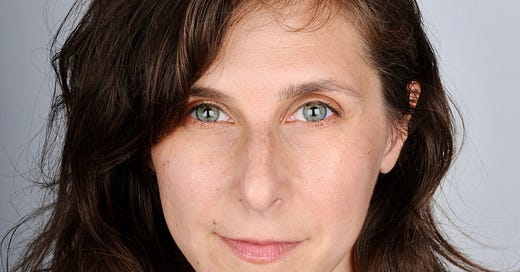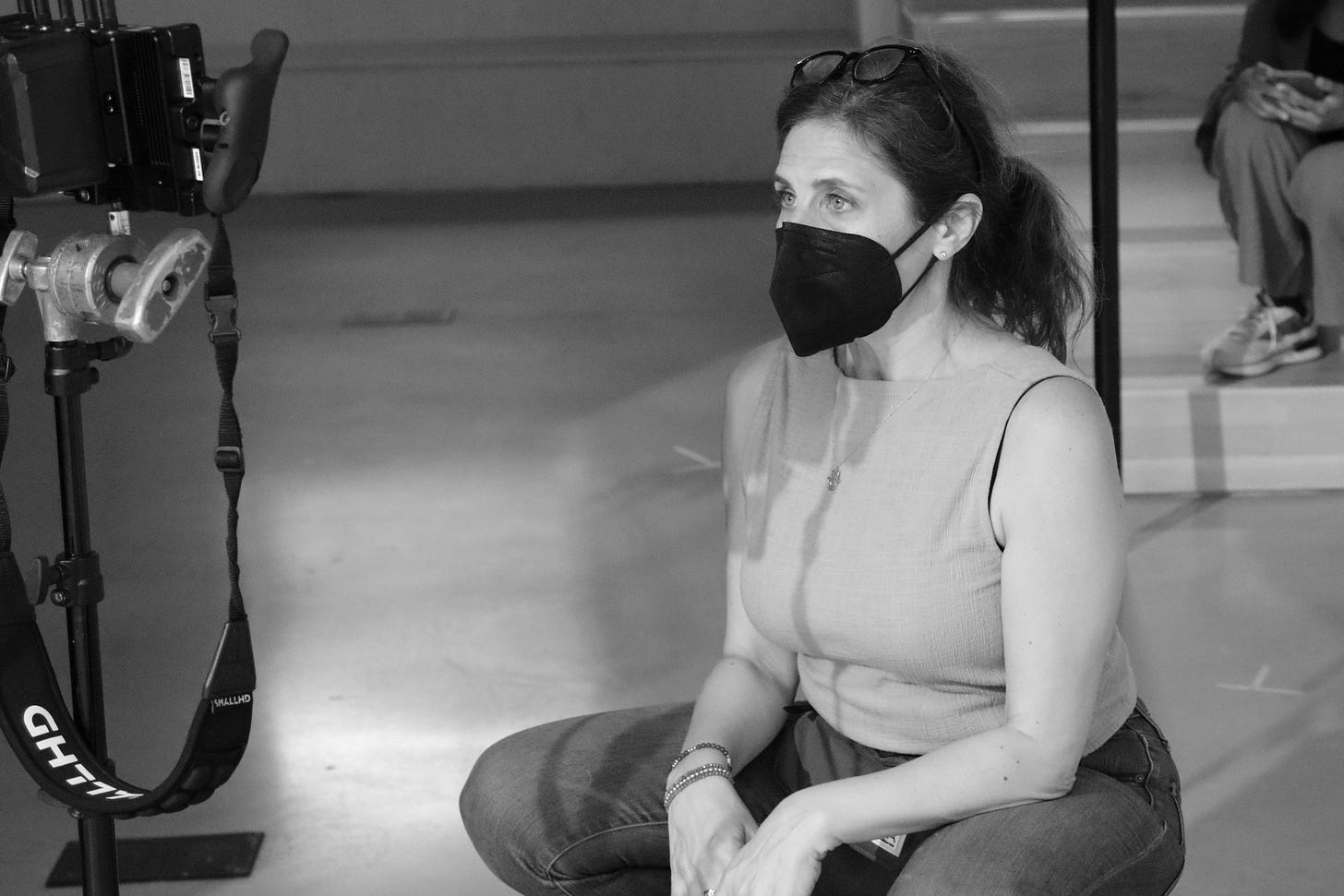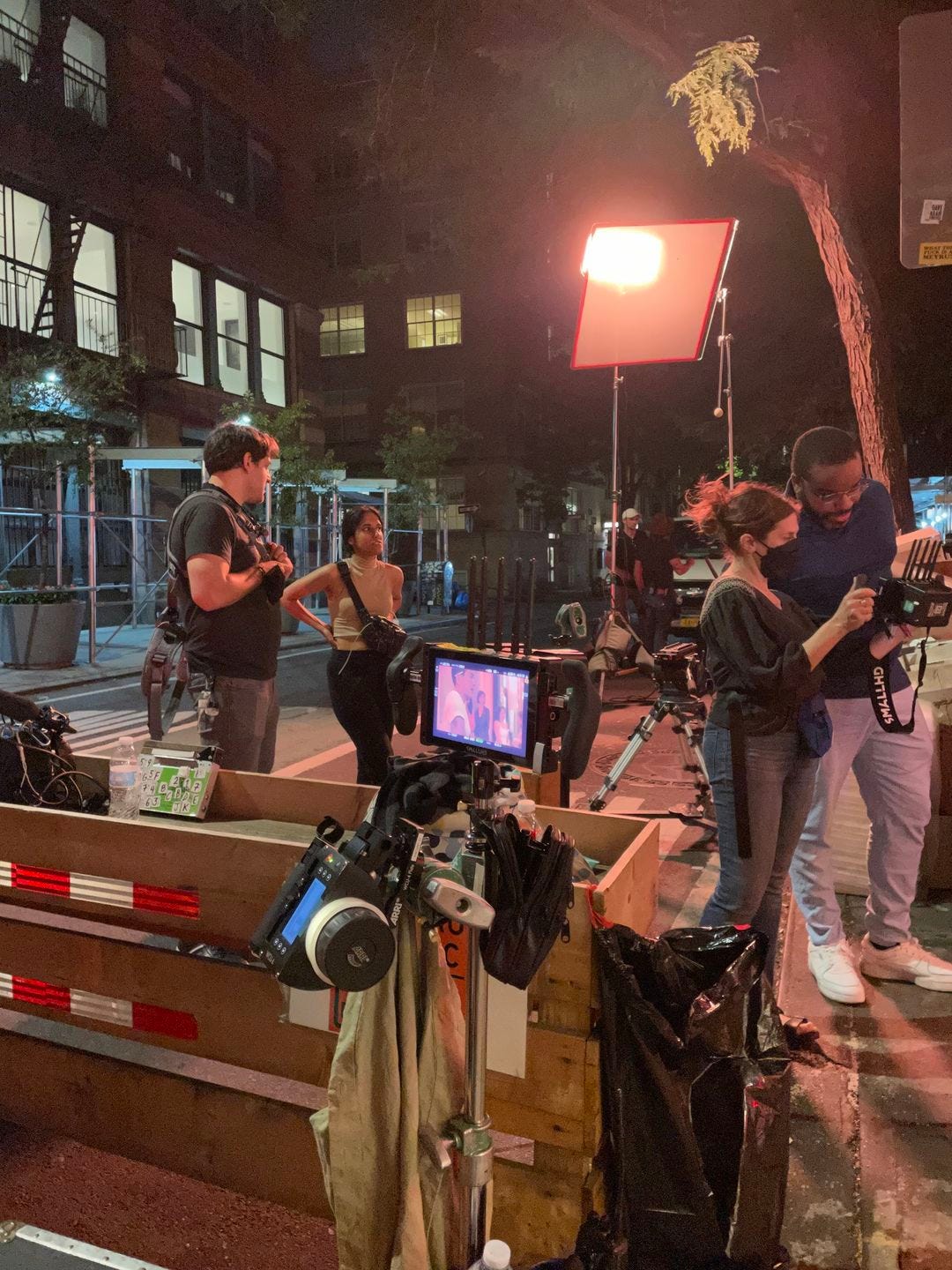Interviewing: Brooke Berman
She started in the theater as an actor and a playwright. Now, this New York-based writer-director is bringing her ideas to the screen in her first feature film, Ramona at Midlife.
Hello! Thanks for reading and subscribing to watch this: feel that - film & TV recommendations for the mood you’re in, or how you want to feel. If you’re new here, welcome! Feel free to visit my About page to find out more about me, and my Archive for past recommendations, reviews, interviews, and more.
This week, I’m happy to share another edition of Interviewing — a series featuring actors, directors, writers, and other cast and crew, where you can discover more about their career journeys, what goes on behind the scenes on set, the films and TV series that make them feel, and the stories they want to tell.
In February, I was scrolling through my Substack Notes feed, reading poems, saving recipes, and discovering personal essays. Then, somewhere between the posts from writers hitting 10K subscribers and those asking themselves, “Is this thing on?”, I stumbled upon this post from playwright, screenwriter, memoirist, and director, Brooke Berman:
I loved how real her celebratory post was. Although I didn’t know her and hadn’t yet watched her movie, Ramona at Midlife, I wanted to know more, so I clicked on the link to read the Spin Magazine article, which included a short essay Brooke wrote called Dear Patti Smith.
An excerpt:
I had been a theater artist for as long as I could remember. It was the only thing I ever wanted. And now, as the mother of a barely sleeping toddler, knee-deep in kids’ music and Open Play, I needed to know how to connect what felt like disparate identities—Mommy, Writer, and Woman. Patti Smith seemed to know the answer. I knew she knew. And I wanted her to tell me. I wanted her to write me a poem or give me a map and show me just how I could become the next version of myself but even more to the point, how I could be present for my son and Art without breaking in two. I wanted her to tell me it would be okay.
I had a hunch that other women in the Substack universe might relate to these disparate identities. So, I reached out for an interview. Then I watched her movie, which made me laugh, think, and want to know more about the woman who wrote it. So, without further ado, my interview with Brooke Berman:
Heather Heagney: Your movie, Ramona at Midlife, is very funny! I loved the lead actress, Yvonne Woods. In the film, Ramona is a writer and single mother who is navigating life and relationships, and she writes letters to her muse, rockstar Patti Smith. I’m curious, is Ramona’s story inspired by your own life?
Brooke Berman: It's not autobiographical — I wrote the character for the actress who plays her, Yvonne Woods. She and I have been collaborating for probably 30 years. She was an actor in the Juilliard program when I was a playwright. I just love her work so much! But I do live in Queens, and I am a mom!
How did you get started as a playwright? And have you always wanted to be a writer?
I wanted to be an actor from the time I was a little girl, but I always wrote. I didn't connect acting and writing until I got to college, when I started performing a short story I had written. I got excited about the idea of performing my own writing because there were so few really interesting, meaty roles for young women. In the February 27 issue of Substack, I interviewed [Writer and Director] Marielle Heller, who says the exact same thing, that as a young actor, there were like, three or four different roles [women] could play.
I got excited about writing things for my friends and me to perform. It didn't morph into like a proper playwriting track until I was in my mid-20s, and at that point, I wrote a play that got produced, and I was like, ‘Oh, that's kind of interesting. What do playwrights do?’ and I set about learning how to do it.
Speaking of Marielle Heller, I recently watched her newest film Nightbitch, which is about an artist who pauses her career to become a mother, and how she rediscovers herself. Although motherhood isn’t the central story of Ramona at Midlife, I can’t help but draw some parallels. Are you open to sharing how your writing career has evolved since becoming a mother, and how you navigated this change?
Before I had my son, I would wake up early, make myself a cup of coffee, do yoga, and then get my writing done first thing, when my mind was the clearest. In the afternoon, I would do my income jobs. In the evenings, I was generally at the theater1. I would see my friends’ plays, readings, and screenings — I was part of a community. Sometimes I would get a job or a development opportunity that involved travel.
Once I had my baby, none of those things were possible anymore. I was up every three hours nursing him, and he would wake up at five in the morning. I wasn't out in the evenings because I was really tired. I was living in Los Angeles, so I didn't have friends doing plays all the time. Suddenly, I was in film and TV culture, and that work revolved around pitching and being available to go to pitch meetings. My girlfriends, who were writing for television, had full-time childcare. So, everything about the way I knew my life had to change, and everything about both the way I did my work, and the way I presented in the world, it all had to go out the window, because my son came first.
It's a shift in identity, and I think there's a kind of collating of identities that happens anyway in middle age. But it felt very intense, because suddenly I was no longer the person that I knew, where I had been an artist first, and everything else second. I was a mom first, and a partner. I'm married, so it's not just motherhood and art, it's also being a decent partner, so all of those things had to sort of live together in the world, and I had to reweave how to think about them. And yes, I did think Patti Smith seemed to know something about that reweaving. And I wished I knew her and could call her up and ask her what to do.
As you were becoming a playwright, did you have any influences or teachers who helped you develop your writing style?
Because I was an actor, I came up through the theater, so I had great mentors and teachers. I studied with Anne Bogart, who is a theater director here in New York. Quite early, I saw a play by María Irene Fornés, and I was really inspired, so I figured out how to study with her. A dramaturg here in New York who recently passed, Morgan Jenness, was a mentor and an influence of mine, and my first agent. When I saw playwright Naomi Iizuka’s work, I got chills. I felt like her work gave me the permission to be myself in my work. And, at Juilliard, I studied with extraordinary playwrights, Marsha Norman and the late Chris Durang. I also developed some early stuff with this company called Naked Angels. They had a program called Tuesdays@9 where you could bring in a couple of pages of work, and actors would show up and read the pages. Theater is a collaborative form, so I always went and found the community, and that inspired me.
And what about film, were there any writers or directors who influenced your style?
I love Sofia Coppola's work. The first time I saw Lost in Translation, I loved the minimalism of that film. I love Jean-Luc Godard — when I saw Breathless, I was like, ‘Oh my God.’ I also love Nora Ephron, and I was really in love with Hal Hartley's films in the ‘90s. He was an alternative indie filmmaker, and I loved what he was doing with rhythm, and the way his world felt super theatrical and a little stylized — kind of like he was doing Godard, but on Long Island, which was this interesting juxtaposition to me.
How did you go from writing plays to writing and directing films?
I wasn't making films until I sold the rights to one of my plays to a movie star, and I got the Hollywood experience, which was all the things you think it's going to be — it was amazing. Then…the movie didn't get made. I worked as a screenwriter for a decade. I moved out to LA because I'm a very experiential learner, and I wanted to absorb the culture of movie-making so I could speak to what it was. While I was there, the thing that I noticed is that the kinds of movies I like and that I instinctually write are generally made by writer-directors. So, I realized that the director was the person who could get a project made and champion the work, and the director sets up how the movie will be rendered. How it gets rendered is the most exciting part to me, so I wanted to see if I could direct. I wrote a short that a friend of mine directed, and I was on set to watch him. Then I went and made one of my own. And I was like, ‘Oh, okay, I can do this.’
I learned to write plays through being in them; I understood the culture of making a play. I wanted to be able to do the same thing with movies, because movies are made really differently. They're shot out of order, the process of getting the financing is different, and the relationship between the writer and the director is totally different. And having a whole post-production process added on — we don't have that in the theater, it all kind of happens at once. As a playwright, no one ever asked me about visual logic because I collaborated with directors, but as a filmmaker, it's all about visual logic.
Tell me more about this visual logic — how did you go about bringing your writing to the screen visually, for example, with this movie, Ramona at Midlife?
I always knew [Ramona at Midlife] was going to be a movie, so I wrote it [that way]. I saw it. In terms of finding the visual logic, there are films that show what I would call ‘elevated real life’ that inspired me, like Tamara Jenkins’ film, Private Life, starring Kathryn Hahn. [That film depicted] a relatable everyday midlife woman in New York City, but there was something about the visual language that felt elevated, and there was a little more light than in real life. The way the camera felt — it was so integrated into the storytelling, it wasn't looking at her from a distance. And I love Joey Soloway’s work. They had this film called Afternoon Delight, also with Kathryn Hahn, that I responded to, the way they used the camera and the light. So, I know which filmmakers I like, and I knew what genre this movie would fall into.
I felt that the camera was a part of Ramona’s emotional world — it wasn't commenting on her world, it was in it with her. Because so much of what the movie's about is [Ramona] making room for herself, that's how we shot it. In the beginning, it would feel a little more cluttered and compartmentalized. Then, as time went on, the color palette and the visual world would open up so that she could be in the center of her own frame.
Do you have any advice for other women writers who want to tell their stories for the stage or screen?
Tell your story and tell the truth. Write what you know and write it as truthfully, fully, and courageously as you can. Don't try to make it clever or commercial. And by your story, I don't just mean your biography. I mean, what do you love in the world? What drives you crazy? Where are your obsessions? What brings you joy? Who are your ghosts? What are you enraged by? That, to me, is your story. Then, find an artistic family — the people who are going to help you make that work. Get that work made however you can, whether that's a local open mic or stand-up group, or shooting it and putting it on YouTube, or finding a theater company that develops new plays. Make the work and then share it with people — that's the best part.
How did your community help you with Ramona at Midlife?
Everyone who was involved with making this movie was already in my circle. Except for Joel de la Fuente, who plays Carlos, they were all actors I'd worked with before. The music supervisor is a former Broadway theater sound designer who's designed a bunch of my plays. The locations were mostly donated to me by people I already knew. The costume designer, Serena da Conceicao, was a friend from my writers group. The production designers I found because a friend of mine was their mentor at NYU, and they were recent graduates in her design program. The caterer is my neighbor. That's a testament to the power of community and finding your tribe.
Lastly, in the vein of this Substack, which is about film and TV and how it makes us feel, can you recommend a movie that truly made you feel something?
I recently saw the remastered big screen re-release of Wim Wenders’ Paris, Texas, and I love it so much. It made me feel all sorts of things.2
If you enjoyed this interview, please leave a comment, tap the little heart to tell me you liked it, share it on Substack Notes, or forward this email to a friend.
To watch Brooke’s movie, Ramona at Midlife:
In Canada, you can rent it from Apple TV, YouTube, or Google Play.
In the U.S., rent it from Amazon Prime Video, Apple TV, Amazon Prime, Fandango, YouTube, or Google Play.
For this interview, when Brooke is “talking”, I’m spelling words like theater and color using American English.
This interview has been edited for length.










Great interview!